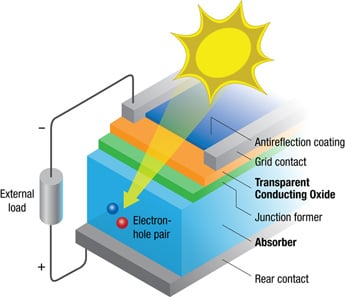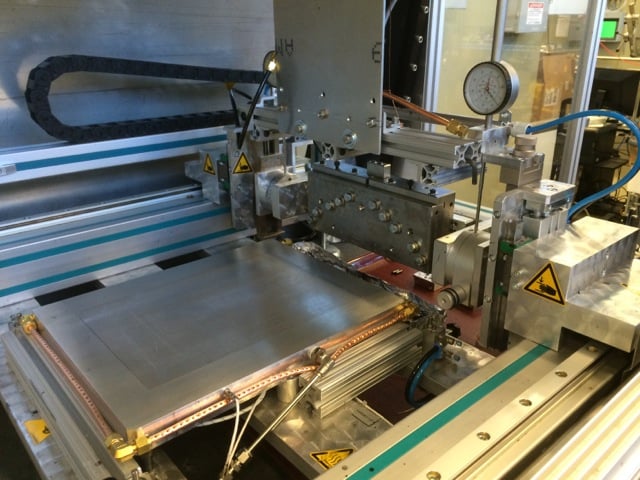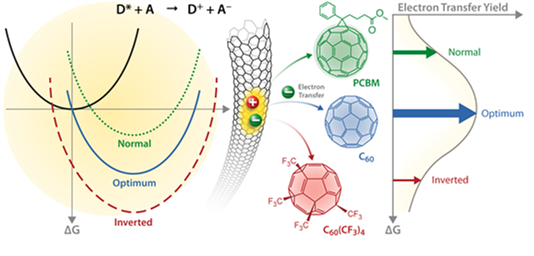Organic Photovoltaic Solar Cells
NLR has strong complementary research capabilities in organic photovoltaic (OPV) cells, transparent conducting oxides, combinatorial methods, molecular simulation methods, and atmospheric processing.
From fundamental physical studies to applied research related to solar industry needs, we are developing the materials, device structures, and tools needed to create polymer-based solar cells that are flexible, lightweight, and inexpensive. Our primary work focuses on photovoltaic (PV) cell research. But our advances in understanding and creating new materials and processes are also being applied in such areas as organic light-emitting diodes and thin-film-transistor displays.

In developing OPV devices, NLR is making advances in materials, deposition and processing of materials, and fabrication of devices under ambient temperature and pressure conditions.
OPV is a rapidly emerging PV technology with improving cell efficiency (currently 18.2% certified), encouraging performance lifetime (>10 years unencapsulated), and demonstrated potential for roll-to-roll manufacturing using solution processing. The building-integrated PV market may find OPV especially attractive because of the availability of absorbers in any color and the ability to make efficient transparent devices.
OPV's great strength lies in the diversity of organic materials that can be designed and synthesized for the absorber, acceptor, and interfaces, but we need to further improve scaling efficiency and lifetime to large area modules. We must understand the fundamentals of device operation, including charge-separation processes, charge-transport mechanisms, device physics, and interfacial effects. This will allow us to design more efficient, stable device architectures based on materials with improved energy-level alignment, spectral response, and transport properties.
Our Expertise

NLR scientists use this coating system to fabricate OPV films in the lab.
We have expertise in:
- Solution deposition of organic and inorganic thin films by spin coating, spray deposition,
blade coating, microgravure printing, and slot-die coating
- Thin-film deposition by sputtering and pulsed-laser deposition, with related characterization,
analysis, and mapping capabilities
- High-throughput combinatorial materials science
- Large-scale molecular dynamics simulation of molecular films and blends of molecular materials
- Scale up manufacturing R&D.
Our researchers have invented and transferred OPV technologies to industry, and we develop cells with improved performance, reliability, and cost-effectiveness. In addition, members of our group are key organizers and participants in industry-wide conferences, such as the Organic Photovoltaics Meeting and International Summit on OPV Stability.
Research Areas

Charge transfer between carbon nanotube absorbers and fullerene acceptors. Such studies provide information on the energy loss necessary for charge separation in OPV and inform material development of future OPV systems.
Our R&D addresses key challenges in these areas:
- New absorber, contact, and barrier materials
We develop and apply new high-performance absorber materials for improved performance and lifetime, focusing on improving photovoltage and stability to photo-oxidation. - New electron/hole contact layers
We have the scientists and the tools to combine molecular design using computational resources with organic synthesis to develop new acceptors and donors to enhance device performance and lifetime. - Mechanisms of materials and device degradation
We investigate and demonstrate new materials and device architectures that mitigate degradation, leading to improved device stability. We have developed a combinatorial degradation system that allows us to measure the lifetime of thin-film devices under light, at different substrate temperatures, with or without filters, or under different duty cycles. This system enables us to evaluate the lifetime of a large number of samples under the same or varied conditions in a parallel manner. In addition, the our solar parameter analysis system enables a unique suite of long-term reliability characterizations on individual PV cells. - Mechanisms and driving force dependence of charge transfer between donor and acceptor
materials
We study the fundamental mechanisms of charge transfer between photoactive polymers and engineered fullerene molecules or carbon nanotubes.
Tools and Capabilities
We have resources and scientists available for R&D in the OPV area, including thin-film deposition, high-throughput combinatorial methods, and atmospheric processing.
- Rapid computational design of novel absorbers
NLR developed the Computational Database for Active Layer Materials for Organic Photovoltaic Solar Cells with calculations on electronic properties of tens of thousands of new polymers and small molecules that are potential candidates for new absorbers. - Large-scale atomistic simulation (~100,000 atoms) of solid-state polymer film structure
and morphology
STREAMM toolkit allows simulation of film structures of new molecules in a semi-automated manner for rapid screening of candidate absorbers. - Femtosecond photoluminescence, transient absorbance, and transient terahertz spectroscopy
These techniques allow us to study the dynamics of excitons and charge carriers and to study charge transfer at interfaces. - Transient microwave conductivity
This unique tool is extraordinarily sensitive to free charge carriers and allows for the very sensitive study of carrier generation and charge transfer at solar-relevant light intensities. - Solution deposition of organic and inorganic thin films
This includes spin coating, spray deposition, blade coating, microgravure printing, and slot-die coating, with capabilities that include:- A thermal evaporator housed in an inert environment that is available for metal evaporation for completing devices
- A solar simulator, external quantum efficiency unit, Kelvin probe, probe station, and impedance spectroscopy in an inert atmosphere
- Hood space for organic synthesis capabilities.
- Long-term stability testing
The OPV team employs a system for testing the long-term stability of hundreds of prototype cells in parallel to rapidly screen new materials and device concepts for stability. - Atmospheric processing
- This reduces overall cost and scalability issues of PV production.
- We develop "inks" and ink-conversion processes to create desired materials with desired properties.
- We develop atmospherically processable materials that include metals, semiconductors,
and oxides.
- Stand-alone atmospheric processing
- Tabletop inkjet printer for testing inks and commercial-style inkjet printers
- Ultrasonic spray stations
- Sheet-to-sheet slot-die coater
- Roll-to-roll deposition with microgravure printing and slot-die coating
- Laser scribing to enable monolithic interconnection and edge delete
Projects
U.S. Department of Energy's SuNLaMP
FY2016–FY2018
This work has the goal to develop high-efficiency, stable OPV solar cells, with a dual focus on computationally predicting film morphology and charge-transport characteristics and on identifying and mitigating common polymer degradation pathways.
U.S. Department of Energy
The Solar Photochemistry core program is interested in fundamental aspects of solar photoconversion, including excitonic effects, charge transport, and charge transfer between layers. Fundamental understanding of charge transfer between organic materials and novel excitonic processes such as singlet fission are a major focus within one of the main thrusts of the core program.
Cooperative Research and Development Agreement
SolarWindow Technologies Inc. is developing a transparent electricity-generating OPV film for glass and flexible plastics. SolarWindow™ coatings, when applied to window glass, have the potential to transform buildings into power plants, a near-term goal. The films are tunable for color and power, and they can be customized for a variety of applications. SolarWindow coatings are being developed for low-capex, high-throughput manufacturing, and they generate electricity in sunlight and artificial, diffused, reflected, shaded, and low-light conditions.
Working with Us
Learn more about PV partnership opportunities.
We transfer our technological advances to major industrial players through licensing and high-value cooperative research and development agreements. Some examples of our past and present industrial collaborations include:
- ConocoPhillips (new absorber materials for organic photovoltaic systems)
- Plextronics (contact development and lifetime of OPV)
- TDA Research (multicomponent systems for infrared absorption)
- Luna Innovations (carbon nanosheet electrodes for OPV)
- Konarka, TOTAL, Solarmer, Department of Defense, and others.
Contact
Share
Last Updated Dec. 10, 2025
